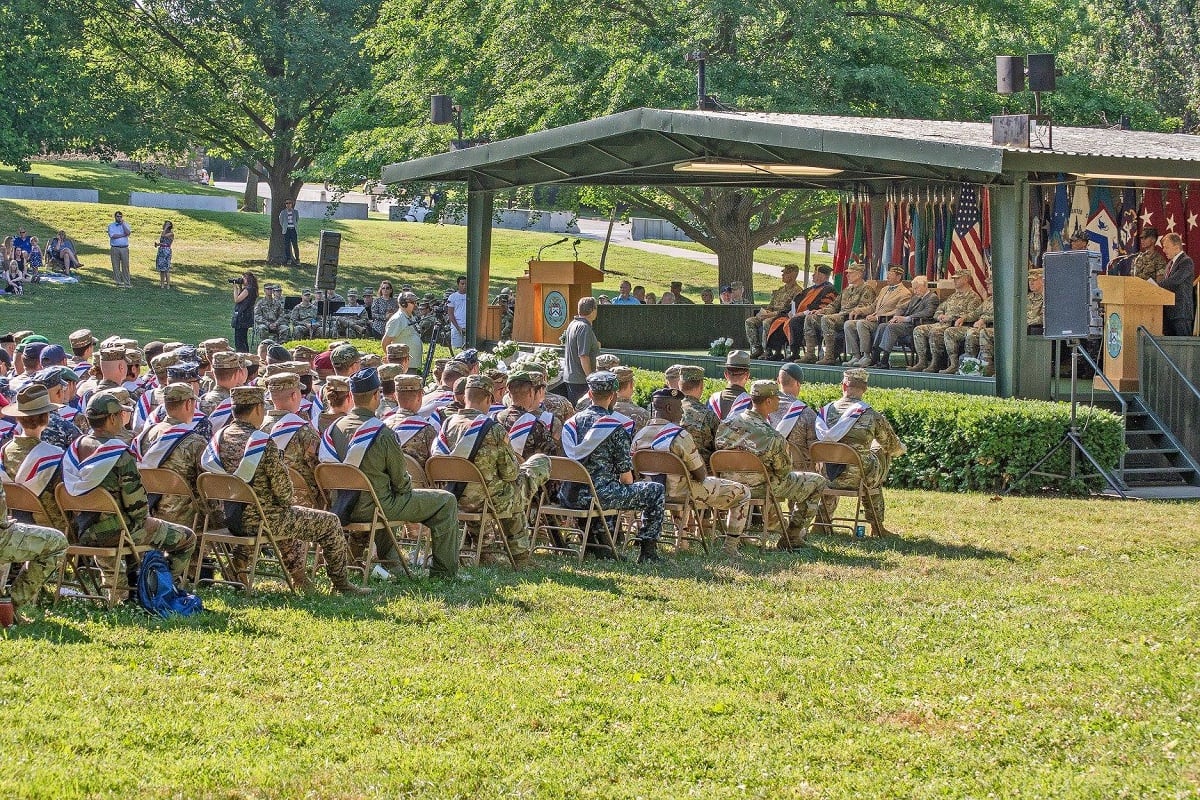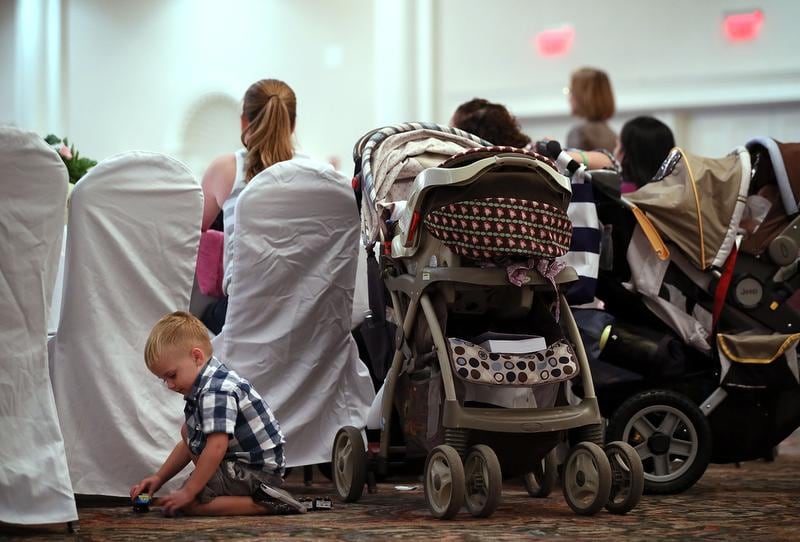It all started back in 2016, when the secretary of defense extended maternity leave for female service members from six to 12 weeks. It was a relief for women in the Army, especially those trying to find a way to advance in the ranks while raising a family.
But for some mid-grade officers, it turned into a road block ― a disqualification from attending an in-residence course that would prepare them to take battalion command or work as battalion, brigade or division staff officers, in addition to earning a master’s degree.
It was a particularly rude awakening a year ago, for three women who reported to the Command and General Staff College at Fort Leavenworth, Kansas.
“Even though there has never been a problem with pregnant service members completing course requirements, CGSC has created a policy that prevents pregnant students from attending in the first place,” according to a Task & Purpose editorial submitted by two majors, one of them who had recently completed CGSC.
Maj. Jenny Gunderson, a co-author, wrote that she and two other women were told they’d have to drop out because of their pregnancies ― or more specifically, because their potential 12-week maternity leaves would violate existing attendance rules.
“But, they added if she were to come back next week and not be pregnant, they would reconsider,” Gunderson wrote of her own experience. “She asked if they were insinuating she should get an abortion, to which she received no response.”
They successfully appealed to leadership and were allowed to finish school.
"This policy is not a screening tool for attendance,” CGSC’s deputy commandant, Brig. Gen. Scott Efflandt, told Army Times on Friday, denying the idea that his school would try to keep pregnant officers out. “Have we encountered absences before and had to deal with them? Yes.”
Though the women were able to complete the program, with tailored make-up plans, they had to fight for reconsideration “at the expense of the students' time,” Efflandt added.
“Ultimately the system prevailed, they graduated and they’re going to go do great things for the Army,” he said.
But Gunderson’s editorial is only one piece of a years-long struggle at CGSC.
Women in the military often try to time their pregnancies with non-operational assignments, and schools can be the perfect environment, as schedules and job demands smooth out for the mostly predictable rhythm of a classroom.
Policy dictates a limit on the number of absences a student can have, and allows the administration to disenroll students who are likely to need multiple weeks off. Before 2016, the six-week maternity policy was good-to-go. Afterward, it threw a wrench in the works.
In the immediate wake of the new maternity leave policy, staff worked with women individually to prepare for how they would navigate delivery, maternity leave and making up any missed work, a former instructor told Army Times on Tuesday.
“We laid out a whole plan,” said retired Lt. Col. Marie Pauley, a former instructor, for the first pregnant woman to come into her team after the policy change.
With an August start, the woman would likely give birth in January, so they pinpointed what she would be missing and the best ways to make it up, including scheduling when she would take on leadership positions during the program, so that she wouldn’t miss an opportunity during maternity leave.
“If they think they can handle it, they know what they’re getting into,” Pauley said, adding that some women opted to take less than the maximum amount of leave so that they could get back to class.

But before the 2017 cycle began, leadership pushed out a new policy disqualifying enrollees who would need to miss more than 15 consecutive days of instruction. This allowed for emergencies, but directly targeted pregnant women, Pauley said, because their absences were “anticipatable.”
She brought her concerns to CGSC’s former deputy commandant, she said, then-Brig. Gen. John Kem. The issue, she told him, was that the school was not letting the women decide whether they could handle the workload and the steps necessary to make up missed time ― it was simply telling them to finish out their pregnancies in a staff job at Leavenworth and return the following year, or to participate in the program via online distance learning.
But not every Army major with command or command staff aspirations gets to go to the in-residence program. Only the top half of their peers can go, and settling for the online version is throwing away invaluable hands-on learning and networking opportunities.
“'The whole thing here, sir, is I never had a choice,'” Pauley told Kem, she said. “Thirty years we’re been pushing for choice. Now we’re finally get choices, and you’re trying to go backward.”
To her knowledge, she added, no pregnant woman has ever failed out of CGSC.
“Women will do it because of their initiative,” she said, adding that maternity is not the only reason students have to miss instruction. “Anybody who has an injury will do it because of their initiative and who they are.”
A ‘misunderstanding’
“One of my large takeaways from the article [in Task & Purpose] was there is clearly a misunderstanding over some pretty important changes, and it’s not clear how the changes are related to making the officers better and meeting the Army’s requirements,” Efflandt told Army Times.
Efflandt took over for Kem in September, inheriting the cohort described in the Task & Purpose editorial. CGSC published a new absence policy in December 2017 to go along with a new curriculum coming online with the class that begins in August, he said.
“The two things that kind of best inform is the length of the absence and the type of material they miss,” he said. “The policy is not about maternity, it’s about not being in class.”
“We didn’t handle those cases when they came in, but the system corrected itself and the officers graduated with their course,” Efflandt said. “We learned from it, and looking at the new curriculum and the new policy, I think we’ll have a better output and a better throughput at the same time.”
The inspector general has launched an investigation into how CGSC handled the situation last year, he said. According to Pauley, that includes reaching down to the women involved, demanding that they not speak publicly about it.
Gunderson declined to comment for this story.
Staff have been retrained on the absence policy and how to handle foreseeable gaps in attendance, Efflandt said.
“I don’t need the person doing the first look [at their enrollment paperwork] to try and do me a favor,” he said, because there are multiple reviews before they begin the program. “This is the way you help them exercise all of their options. That’s what the training focused on.”
Pauley noted that the administrators who spoke to the women were high-level civilians, who were carrying out a specific policy pushed down from the top.
The idea that lower-level staff could have asked leadership for a policy exception due to pregnancies doesn’t ring true, she said.
“Is it incompetence? Is it ignorance? They know what they are doing,” she said. “None of them made decisions without the general knowing. They made it a policy. Their signature was on it.”
School administration and faculty had spent months putting together that absence policy, Kem told Army Times in a Thursday phone interview, in an attempt to standardize the way the program handled long absences in general.
“They kept coming in and going, ‘This is an anti-women pregnancy policy,' ” he said of his female students. “What I tried to explain to them, this isn’t a pregnancy policy. We’re trying to figure out the absence policy for meeting learning outcomes.”
Maternity leave was not the main driver for their decisions, he added, but the timing of the policies had a negative effect on women who had already picked up their lives and reported to CGSC.
Previously, individual faculty members had the authority to sign off on make-up plans, he said. Some would assign just an extra paper to a “good student,” while another officer in a similar situation would get much more work.
“What they didn’t see was, we had spent a number of months talking to the faculty — not about them, but about, how are we ensuring learning outcomes?” he said. "They didn’t see that preparatory side. They were just like, ‘wow, you’re just doing this to us now.’ "
Once confronted, however, Kem said he wanted to make sure that each student’s situation was handled fairly.
“It’s the nature of big organizations,” he said, for policies and their implementation timing to affect people in ways unaccounted for. “But it was always the intent to try to be individual and treat people the right way.”
Army vs. family
For any woman wanting to make a career out of the Army, family planning is at the top of the list of things to consider. The service has a prescribed career development timeline, and to veer off of it has proven detrimental.
“While no one person can guarantee pregnancy on a schedule, it has been the practice of many women in the Army to try to plan a family in conjunction with career milestones, so as not to interfere with career progression,” Lt. Col. Brogan Ferren, who retires at the end of the July and most recently served as a GCSC instructor, wrote in an open letter provided to Army Times.
For that reason, female officers with ambitions toward holding battalion command or above will try to schedule pregnancies around non-operational assignments, so as to prevent their pregnancies from rendering them nondeployable in a unit that would need them in a contingency situation. For instance, while serving as a staff officer rather than a platoon leader or company commander.
RELATED

“Historically, women are removed or restricted from duties that are career enhancing while pregnant, such as combat, or flying, or strenuous physical exertions,” Ferren wrote. "Therefore, being pregnant while in key and developmental positions such as platoon leader, company commander, and operations officer, is not conducive to a high evaluation in these positions due to the limitations placed on pregnant women. That being a fairly well-known stigma of pregnancy, the opportune time to be pregnant was in positions that were not highlighted as key and development, such as a training and doctrine assignment. "
In the case of CGSC, that 10 months can serve as an ideal opportunity to expand a family, then pick up a new assignment after maternity leave.
For the women asked to disenroll, and for their instructors, the new absence policy was a slap in the face of their efforts to responsibly advance their careers and have a family.
“I think being in the Army is a good time to have a family,” Efflandt told Army Times. “There’s no good or bad time to have a family in the Army. That’s a personal life decision and we’re prepared to support it.”
But for the women, Ferren wrote, that couldn’t be further from the truth.
“Another fallacy is the underlying medical status of pregnancy in the U.S. military," Ferren wrote.
While absences are a big issue at CGSC, she wrote, lumping pregnancy in with illness, injury and other personal issues unfairly disadvantages women.
"Pregnancy is not an illness and the Army is treating it as such, rather than celebrating the growth of an Army family,” she wrote. “From a strategic perspective, this medical classification of pregnancy and pregnancy’s status so similar to long-term illnesses (those lasting longer than six months) creates a culture where there is a negative, rather than a positive, stigma attached to building an Army family.”
And while steps have been made both in policy and awareness, Ferren warned that lumping maternity in with family and medical emergencies could have long-term effects on the organization.
“Current trends show that new soldiers are children of old soldiers,” she wrote. “The Army’s decision to discourage growth of Army families through policies like these is strategically short-sighted, and could hurt recruiting numbers in 18 to 20 years by lowering its most likely pool of candidates.”
Meghann Myers is the Pentagon bureau chief at Military Times. She covers operations, policy, personnel, leadership and other issues affecting service members.









